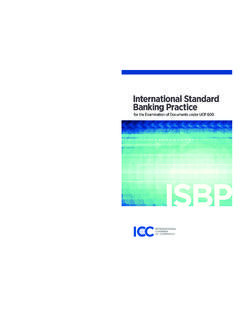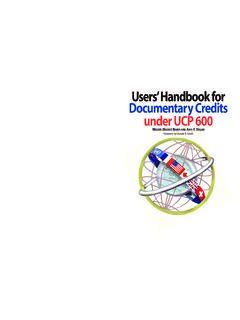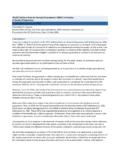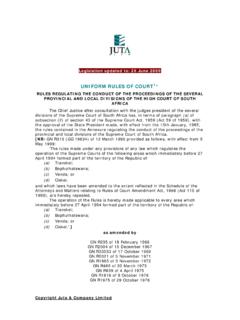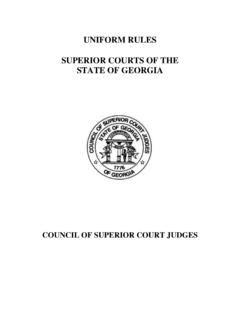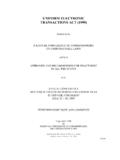Transcription of Guide to ICC Uniform Rules for Demand …
1 Guide to ICC Uniform Rules for Demand Guarantees URDG 758Dr. Georges Affaki Professor Sir Roy Goode QCGuide to ICC Uniform Rules for Demand GuaranteesUsers and issuers choosing the URDG for their guarantees and counter-guarantees will find this Guide an indispensable companion. With its clear and comprehensive commentary on the Rules and the accompanying model forms, this Guide provides the key to a successful guarantee practice in all sectors and jurisdictions. In the Guide , the authors have put the essence of their experience in researching, practising and teaching the law and practice of Demand guarantees over a period of twenty years. They also share their experiences of the revision process leading to URDG 758, revealing the background of each policy choice and drafting decision they took while drafting the Rules .
2 Case studies throughout the Guide support and enliven the comprehensive analytical commentary on the authors, respectively chairmen of the URDG 758 and the URDG 458 drafting groups, debunk the many myths about international guarantee practice and identify pitfalls to avoid. They track in detail the seven key stages of a URDG guarantee s lifecycle: Drafting, Issuance, Changing of terms, Making a presentation, Examining the presentation, Making payment and Termination of the guarantee and counter- guarantee . Combining a practical approach and substantial research, the Guide meets the expectation of bankers, traders, lawyers and Georges Affaki is Chairman of the URDG 758 Drafting Group. He is a member of the Executive Committee and Head of Structured Finance at BNP Paribas, CIB Legal. He is also Vice-Chairman of the ICC Banking Commission and Chairman of the Task Force on Guarantees.
3 Dr Affaki is Associate Professor of Law at the University of Paris II and represents ICC at the United Nations Commission on International Trade Law (UN) Working Group VI Secured Transactions. He is the author of several books and articles on international banking, secured lending and arbitration, including A User s Handbook to the URDG , ICC Pub Roy Goode is Emeritus Professor of Law at the University of Oxford and Emeritus Fellow of St. John s College, Oxford. A retired Queen s Counsel, he chaired the drafting committee at diplomatic conferences for four international conventions. A former Chairman of ICC s Commission on International Commercial Practice, he chaired the Drafting Group that finalised ICC s first Uniform Rules for Demand Guarantees 458 and is the author of Guide to the ICC Uniform Rules for Demand Guarantees , ICC Pub 510.
4 He is a Fellow of the British Academy and was knighted in 2000 for services to academic FINAL 123/05/2011 12:06 Guide to ICC Uniform Rules for Demand Guarantees URDG 758by Dr Georges Affaki and Sir Roy GoodePublished 2011 URDG FINAL 323/05/2011 12:06 Copyright 2011 International Chamber of CommerceAll rights reserved. No part of this work may be reproduced or copied in any form or by any means graphic, electronic, or mechanical, including photocopying, scanning, recording, taping, or information retrieval systems without written permission of ICC SERVICES, Publications Services Publications 33-43 avenue du Pr sident Wilson75116 ParisFranceICC Publication No. 702 EISBN: FINAL 423/05/2011 12:06vPrefaceAbout URDG 758. The new URDG 758 succeed URDG 458. Over 18 years of practice (1992-2010), URDG 458 proved to be both successful and reliable. They were used by banks and businesses across continents and industry sectors.
5 URDG 458 were endorsed by international organisations, multilateral financial institutions, bank regulators, lawmakers and professional federations. Their conciseness and clarity were unanimously appreciated. In contrast to the failed Uniform Rules for Contract Guarantees (URCG 325), URDG 458 reflected the reality of the international Demand guarantee market and struck the most reasonable balance between the interests of all of the parties involved. By choosing to instruct a guarantor to issue a URDG guarantee (as opposed to an accessory suretyship), applicants renounced their ability to obstruct payment for reasons derived from their relationship with the beneficiary. In turn, beneficiaries were expected to state in general terms but not to justify, establish or prove the nature of the applicant s breach in the performance of the underlying relationship.
6 Finally, because a Demand guarantee is an independent undertaking, guarantors were assured that their commitment was subject to its own terms. They were insulated from the performance contingencies of the underlying relationship and were confined to document checking only. Their incremental use, backed by the support of ICC, enabled URDG 458 to make a critical contribution towards levelling the playing field among Demand guarantee issuers and users regardless of the legal, economic or social system in which they operate. For that, the ICC members who foresaw the need for a separate set of Rules for independent guarantees in the early 1980s and had the leadership and the vision to steer URDG 458 towards successful finalisation and implementation deserve need for a change. Yet URDG 458 were the first attempt by ICC to codify independent guarantee practice.
7 Over the years, the application of their provisions shed light on the need for various drafting adjustments, clarifications, expansion of scope or corrections of the adopted standard. Views reported to the ICC Task Force on Guarantees1 from URDG users worldwide provided the necessary material to launch a revision of URDG 458 necessitated by the lapse of time and the evolution of practice. The revision was launched in 2007 and was conducted under the aegis of both the ICC Banking Commission and the ICC Commission on Commercial Law and Practice (CLP).The ICC Task Force on Guarantees, the standing expert body created by ICC in 2003 to monitor international guarantee practice, acted as a consultative body to the Drafting Group that produced five comprehensive drafts during the two-and-a-half-year revision process. Each draft was submitted for review and comments to ICC national committees.
8 Over 600 sets of comments were received from a total of 52 different countries and were thoroughly examined. These comments were instrumental in shaping the new Rules . Regular progress reports were presented to meetings of each of the ICC commissions considering the Rules and were comprehensively debated. This method ensured that views would be received from a broad cross-sector of concerned parties. 1. On the Terms of Reference of the ICC Task Force on Guarantees, see ICC Pub. No. 758 (English version), p. FINAL 523/05/2011 12:06viGuide to Icc Uniform Rules for Demand GuaranteesThe resulting URDG 758 were adopted unanimously by the ICC Executive Board at its meeting in New Delhi on 3 December 2009, following their endorsement by the members of the two sponsoring ICC Commissions.
9 They came into force on 1 July 2010, whereupon a considerable number of Demand guarantees and counter-guarantees started being issued all over the world subject to the new URDG 758. The percentage of guarantees subject to URDG 758 compared to those subject to URDG 458, or to no Rules at all, is increasing by the day and at a very satisfactory rate. The new URDG 758 do not merely update URDG 458; they are the result of an ambitious process that seeks to bring a new set of Rules for Demand guarantees into the 21st century: Rules that are clearer, more precise and more Guide . Users and issuers of Demand guarantees and counter-guarantees, as well as their advisers, will find in this Guide an indispensable companion to URDG 758. With the Rules and the model forms, this Guide forms the triptych on which a successful guarantee practice can be built.
10 In its pages, we have put the essence of our experience in researching, practising and teaching the law and practice of Demand guarantees over a period of twenty years. We also share our experiences of the two-and-a-half-year revision process leading to the new URDG 758, revealing the background of each policy choice and drafting decision that we took while drafting the new Rules . Practical examples throughout the Guide support and enliven our analytical commentary on the Rules . The Guide is divided into five chapters:- Chapter 1 presents an overview of the world of Demand guarantees and counter-guarantees. It explains the fundamental principles of Demand guarantees and the differences from documentary credits, indemnities or accessory Following a prologue tracing the road to URDG 758 and presenting a table comparing the key aspects of URDG 758 and URDG 458, Chapter 2 provides an overview of URDG 758.

